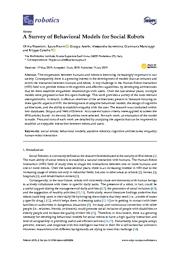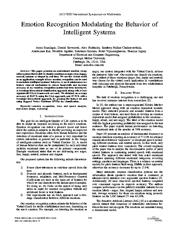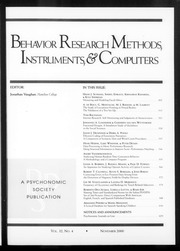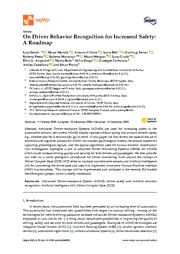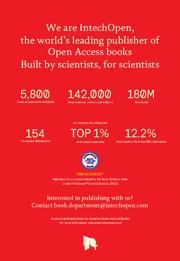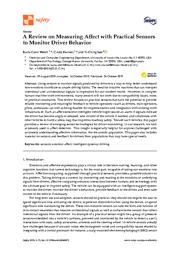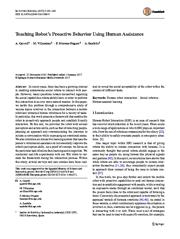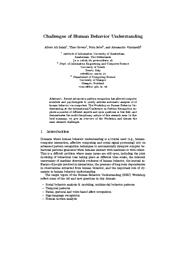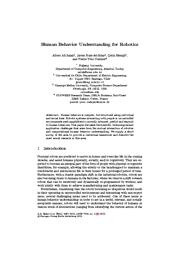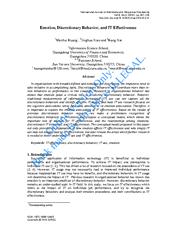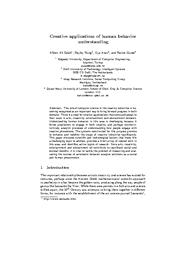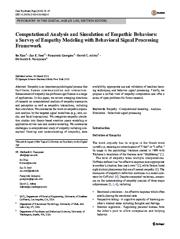A copy of this work was available on the public web and has been preserved in the Wayback Machine. The capture dates from 2020; you can also visit the original URL.
The file type is application/pdf.
Filters
A Survey of Behavioral Models for Social Robots
2019
Robotics
In details, it offers an overview of the architectures present in literature focusing on three specific aspects of HRI: the development of adaptive behavioral models, the design of cognitive architectures ...
For each work, an evaluation of the model is made. Pros and cons of each work are detailed by analyzing the aspects that can be improved to establish an enjoyable interaction between robots and users. ...
Author Contributions: O.N. and G.A. were responsible for the literature research and methodology definition and search strategies for synthesizing the information from the papers into text and tables. ...
doi:10.3390/robotics8030054
fatcat:2tugryoiqzcehgg6ffm3r7jzva
Human computing and machine understanding of human behavior
2006
Proceedings of the 8th international conference on Multimodal interfaces - ICMI '06
on human models. ...
A widely accepted prediction is that computing will move to the background, weaving itself into the fabric of our everyday living spaces and projecting the human user into the foreground. ...
information that the user has passed on. ...
doi:10.1145/1180995.1181044
dblp:conf/icmi/PanticPNH06
fatcat:wyix2qgyrrfczfcthifm3gzfcu
Emotion Recognition Modulating the Behavior of Intelligent Systems
2013
2013 IEEE International Symposium on Multimedia
We use the virtual coach as an application example of how emotion recognition can be used to modulate intelligent systems' behavior. ...
The paper presents an audio-based emotion recognition system that is able to classify emotions as anger, fear, happy, neutral, sadness or disgust in real time. ...
Emotions often drive human behavior and the detection of emotional state of a person is very important for system interaction in general and in particular in the design of intelligent systems such as Virtual ...
doi:10.1109/ism.2013.72
dblp:conf/ism/SmailagicSRCKJGVJ13
fatcat:iwpncmob25gobpzpf6wkivmkka
Page 505 of Behavior Research Methods Vol. 32, Issue 4
[page]
2000
Behavior Research Methods
Indeed, the emerging field of “affective computing” centers on computational mod¬ eling of human perception and display of emotion and on the design of affect-based computer interfaces (Lisetti & Schiano ...
An extensive body of evidence was gath¬ ered on the recognition of a small number of “basic” emo¬ tions: anger, disgust, fear, happiness, sadness, and surprise (contempt was tentatively added only recently ...
On Driver Behavior Recognition for Increased Safety: A Roadmap
2020
Safety
DCS relies on multiple non-obtrusive sensors and Artificial Intelligence (AI) for uncovering the driver state and uses it to implement innovative Human–Machine Interface (HMI) functionalities. ...
In this paper, we first review the state-of-the-art of emotional and cognitive analysis for ADAS: we consider psychological models, the sensors needed for capturing physiological signals, and the typical ...
For that reason, the present research mainly focuses on the recognition of complex human states rather than demographics. ...
doi:10.3390/safety6040055
fatcat:rntcjtvwkjaa5mrxsc2lji5kdy
Behavioral Biometrics: Past, Present and Future
[chapter]
2022
Recent Advances in Biometrics [Working Title]
Behavioral biometrics are changing the way users are authenticated to access resources by adding an extra layer of security seamlessly. ...
The chapter highlights the most trending research directions in behavioral biometrics authentication and presents examples of current commercial solutions that are based on behavioral biometrics. ...
In one study, touch sense was defined and created as an emotion detection model based on typing and swiping patterns of a user with an accuracy rate of 73% [12] . ...
doi:10.5772/intechopen.102841
fatcat:teqp3rmayffp3k4cfygdly4mm4
A Review on Measuring Affect with Practical Sensors to Monitor Driver Behavior
2019
Safety
Such an affect-sensitive intelligent vehicle might sound an alarm if signals indicate the driver has become angry or stressed, take control of the vehicle if needed, and collaborate with other vehicles ...
Toward such vehicles, this paper provides a review of emerging sensor technologies for driver monitoring. In our research, we look at sensors used in affect detection. ...
with an intelligent system. ...
doi:10.3390/safety5040072
fatcat:dntka35d3fb3bf7ficwsmzatkm
Teaching Robot's Proactive Behavior Using Human Assistance
2017
International Journal of Social Robotics
As a proof of concept, we focus on the particular task of online face learning and recognition. ...
an emotional status. ...
Active Learning for Online Face Recognition As mentioned above, the human-assisted facial recognition system was assessed based on the degree of human intervention and its effects on human-robot interaction ...
doi:10.1007/s12369-016-0389-0
fatcat:va2xvfw5qvcmxgbrykcwrhpkim
Modeling emotion for human-like behavior in future intelligent robots
[article]
2022
arXiv
pre-print
We start with an overview of the existing literature on emotion modeling in three areas of research: affective computing, social robotics, and neurorobotics. ...
Overall, we argue that a stronger integration of emotion-related processes in robot models is critical for the design of human-like behavior in future intelligent machines. ...
Toward better models of emotion The brief review of the previous section points to several promising research directions. ...
arXiv:2009.14810v2
fatcat:tnrjwvih2zatlmae62klenmwii
Challenges of Human Behavior Understanding
[chapter]
2010
Lecture Notes in Computer Science
The Workshop on Human Behavior Understanding at the International Conference on Pattern Recognition explores a number of different aspects and open questions in this field, and demonstrates the multi-disciplinary ...
In this brief summary, we give an overview of the Workshop and discuss the main research challenges. ...
The present volume demonstrates that pattern recognition is an essential component of research in this area. ...
doi:10.1007/978-3-642-14715-9_1
fatcat:r2qtb454fbawtj76jcqy67kj6a
Human Behavior Understanding for Robotics
[chapter]
2012
Lecture Notes in Computer Science
We supply a short survey of the area to provide a contextual framework and describe the most recent research in this area. ...
This paper discusses the scientific, technological and application challenges that arise from the mutual interaction of robotics and computational human behavior understanding. ...
-Second, and in a related manner, interaction with an intelligent system (be it a robot, or any artificial or ambient intelligence system) in the loop can produce dynamical evolution of human behavior, ...
doi:10.1007/978-3-642-34014-7_1
fatcat:i2fvsrkp4vfzhkzivzzjk2gwp4
Emotion, Discretionary Behavior, and IT Effectiveness
2014
International Journal of Multimedia and Ubiquitous Engineering
Based on the results of previous discretionary behavior research, we make a preliminary recognition of discretionary behaviors in IT context and propose a conceptual model, which shows the important role ...
However, traditional measurements of information technology (IT) use can not capture all the discretionary behaviors and identify effective IT usage, and most IT use research focuses on the cognitive antecedents ...
Based on the research in organizational behavior, we divide the IT use behavior into inrole behavior and discretionary behavior, and make a preliminary recognition of the discretionary behavior descriptions ...
doi:10.14257/ijmue.2014.9.5.31
fatcat:zwu5d7y63jhhvdlibbkkwarztm
Drive Safe: Cognitive-Behavioral Mining for Intelligent Transportation Cyber-Physical System
[article]
2020
arXiv
pre-print
This paper presents a cognitive behavioral-based driver mood repairment platform in intelligent transportation cyber-physical systems (IT-CPS) for road safety. ...
The proposed platform recognizes the distracting activities of the drivers as well as their emotions for mood repair. ...
Through the association rule mining, the user behavioral pattern is generating so that the system can recommend a candidate set of contents based on the contextual information. ...
arXiv:2008.10148v1
fatcat:oyiacwmolreqrbojrvon2bktje
Creative Applications of Human Behavior Understanding
[chapter]
2013
Lecture Notes in Computer Science
The systems constructed for this purpose promise to enhance and redefine the scope of creative industries significantly. ...
The role of computer science in the creative industries is becoming recognised as an important way to bring forward progress in both domains. ...
Towards the generation of multimodal behavior for a humanoid robot engaged in a collaborative task with a human partner, Mihoub et al. present a probabilistic approach based on hidden Markov models in ...
doi:10.1007/978-3-319-02714-2_1
fatcat:byw43vsce5ep3o3es6khru5u3q
Computational Analysis and Simulation of Empathic Behaviors: a Survey of Empathy Modeling with Behavioral Signal Processing Framework
2016
Current Psychiatry Reports
We categorize empathy simulation studies into theory-based emotion space modeling or application-driven user and context modeling. ...
Empathy is an important psychological process that facilitates human communication and interaction. Enhancement of empathy has profound significance in a range of applications. ...
emotion; (ii) empathy modulation-modulation of empathic emotion (i.e., an emotion likely invoking perceived empathy by human users) as an interpolation of the perceived and own emotion (mood) states in ...
doi:10.1007/s11920-016-0682-5
pmid:27017830
pmcid:PMC5405768
fatcat:gkjcrmnhyne4fhca5wl2jriuli
« Previous
Showing results 1 — 15 out of 29,222 results

